Whether you’re a collector, a gem enthusiast, or just curious about natural wonders, it pays to know how to identify agate. This article is your guide to getting to know this gemstone that’s been admired for centuries.
You might have seen agate in jewelry, as decorative pieces, or even in practical items like coasters. Its popularity brought on many fakes that are sold for the price of genuine pieces. That’s why it’s important to know how to tell if agate is real.
We’ll share some handy tips that will help you distinguish real agate from imitations. By the end of this article, you’ll be able to look at an agate and, using simple observation techniques, tell whether it’s real or fake.
Overview Of Natural Agate And Why Fakes Are Common
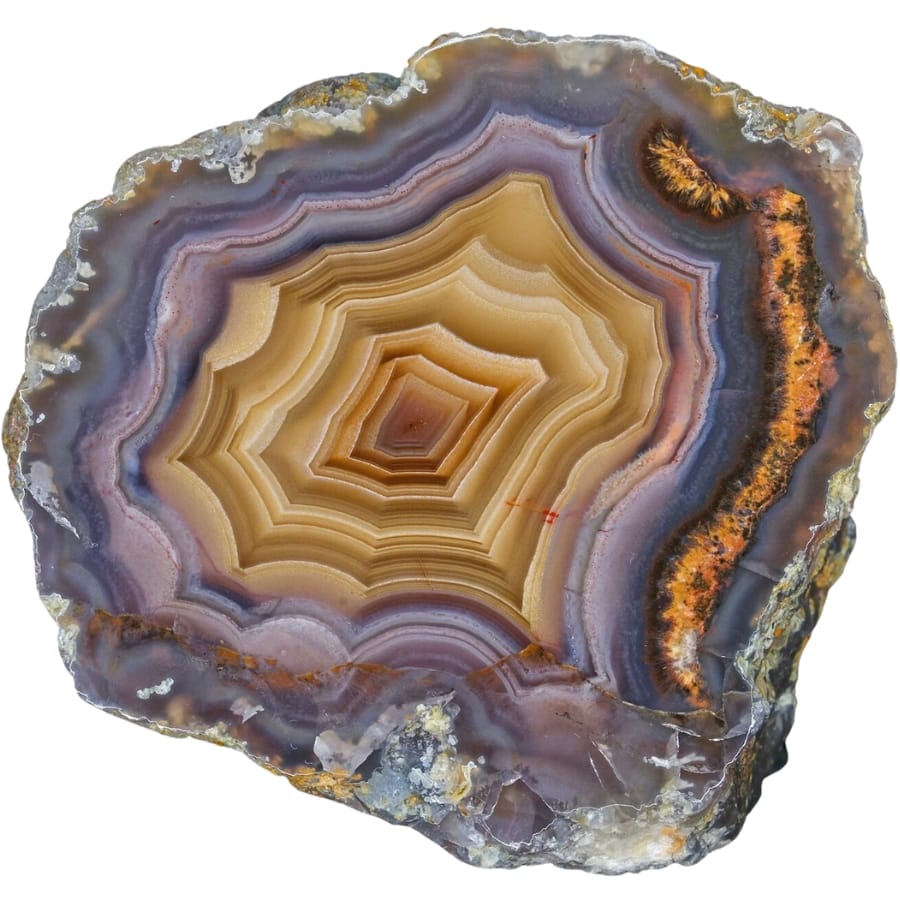
Agate is formed through the activity of ancient volcanoes. When the lava from these volcanoes cooled down, it trapped water inside. Over a long time, this water, filled with different minerals, slowly formed layers and turned into agate.
One of the coolest things about this rock is its layers. These layers create unique patterns and colors. You’ll find agate in many colors like red, blue, green, and even multi-colored. Some have such fine layers they almost look like paintings!
In fact, agate’s value is influenced by its uniqueness and beauty. The more unusual and striking the patterns and colors, the more valuable the agate is. Rare types of agate, like fire agate with its fiery colors, can be especially valuable.
But agate is not just pretty to look at; it’s also quite tough. It’s durable and resistant to scratches, perfect for everyday use.
In ancient times, this rock was carved into tools, decorations, and even as protection against bad luck. Today, it’s popular in jewelry because of its beauty and strength. It’s also used in decorative items like bookends, coasters, and sculptures.
Why you’re seeing more fake agate these days
The rise in fake agate stones in the market lately is due to several reasons. First, agate is really popular. Lots of people love it for its beauty and unique patterns. Because of this, some sellers try to make more money by making fake ones.
Another reason is technology. It’s easier to make stones that look like agate. These fakes can be made from cheaper materials that are dyed and treated to mimic agate’s colors and patterns. This process isn’t hard or expensive for tricky sellers.
Also, it can be difficult for regular buyers to tell the difference between real and fake agate. A well-made fake can look pretty convincing, especially if you’re buying online where you can’t touch or closely examine the stone.
Lastly, the demand for unique and rare types of agate has grown. Some of these rare agates are hard to find or expensive. That’s why dishonest sellers sell these fakes for high prices, tricking people who think they’re getting something special.
How To Identify Real Agate
Learning how to identify your rock is important in making sure you are investing in a real one. Here are a few tips to help you successfully identify an agate:
Look at the patterns
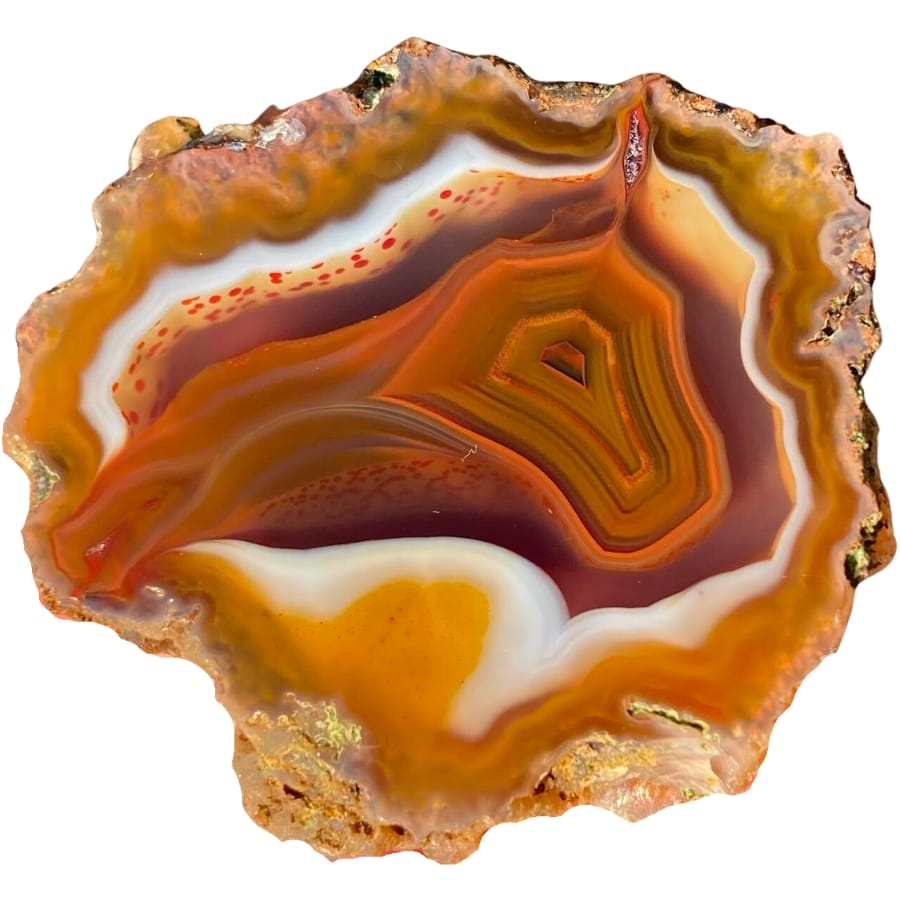
Real agate is known for its unique and irregular banding. These bands are like wavy lines or stripes that you can see inside the stone. Each agate has its own pattern that’s like no other. It’s kind of like how every person’s fingerprint is different.
Fake agates try to copy these patterns, but they often don’t get it quite right. Their patterns can look too perfect or all the same. It’s like someone just drew neat lines or circles on them.
Also, real agate’s bands can have different colors and might blend into each other. In fakes, the colors can look too bright or just not natural.
So, when you look at an agate, check if the patterns are random and uneven, with natural colors blending together.
Check the hardness
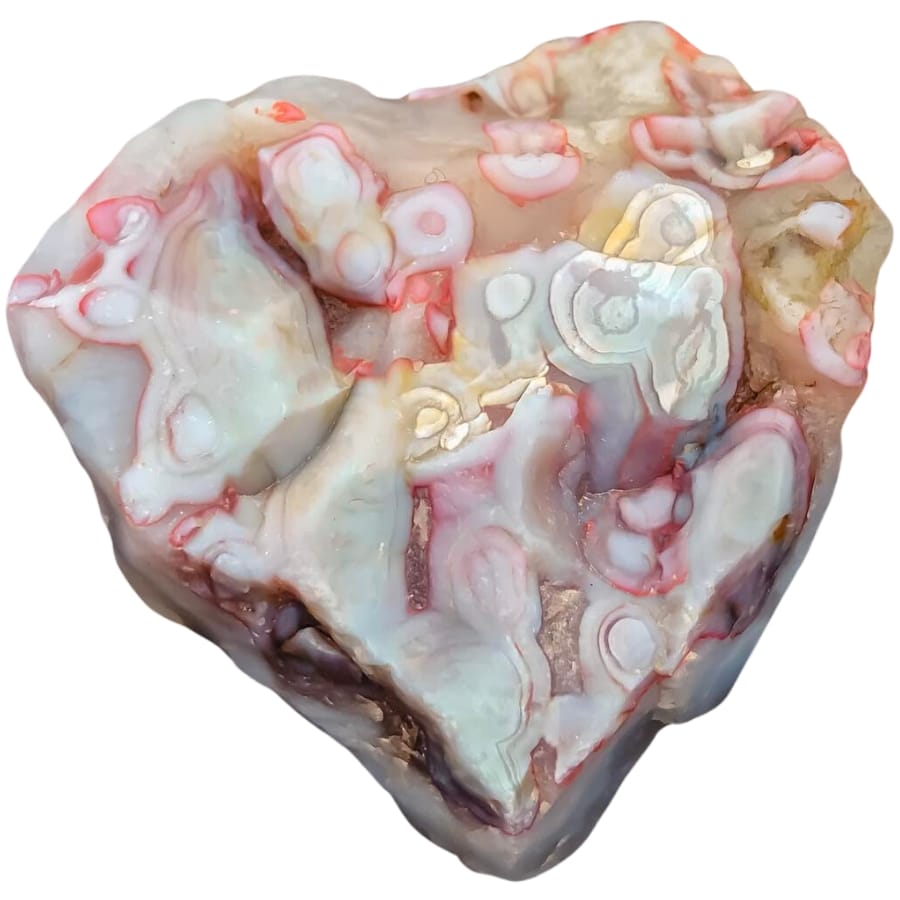
Agate is quite hard. It scores around 7 out of 10 on the Mohs Hardness Scale, which is used to measure how hard different minerals are.
If you have a stone and you’re wondering if it’s real agate, you can do a scratch test. Take a steel nail, which has a hardness of 6.5 on the Mohs scale, and gently try to scratch the stone with it.
If the stone is real agate, the nail shouldn’t be able to scratch it. But if the stone gets scratched easily, it’s likely not real agate.
This test helps because fake agates are often made of softer materials like glass or plastic, which can be easily scratched.
Feel the weight

Agate is a type of quartz, and it’s pretty heavy for its size. This is because it’s made from dense, natural materials that pack a lot of weight into a small space.
When you pick up a piece of agate, it should feel heavier than it looks. This is a good sign that it’s real.
On the other hand, fake agates, which might be made of glass or plastic, usually feel lighter than you’d expect. These materials just don’t have the same weight as natural agate.
When you’re checking a stone, hold it in your hand and see how it feels. If it feels satisfyingly heavy, like it’s packed full of natural stuff, there’s a better chance it’s real agate. If it feels surprisingly light, like it’s not quite solid enough, it might be a fake.
Examine under the light

Agate is kind of see-through or translucent. This means that when you hold it up to the light, some light will pass through it, but not all. You’ll be able to see the light shining through the layers and patterns of the agate, which is pretty awesome.
When you do this with a real agate, you’ll notice the light showing through it in a unique way. The stone might glow a bit, and you can see the different colors and bands inside it more clearly.
But if you try this with a fake agate, it often doesn’t work the same way. Fake agates may not let light pass through them in the same natural, beautiful way.
They might look more solid and block the light completely, or the light might pass through in a way that just doesn’t look right.
The Different Types Of Fake Agate And What They Look Like
If you know the right places where to find agates, you have a great chance of not being duped with fake ones. But if you prefer buying it in stores or online, you should be wary of the different types of fake agates out there.
Below are some of the most common fake agates that might fool you:
Glass
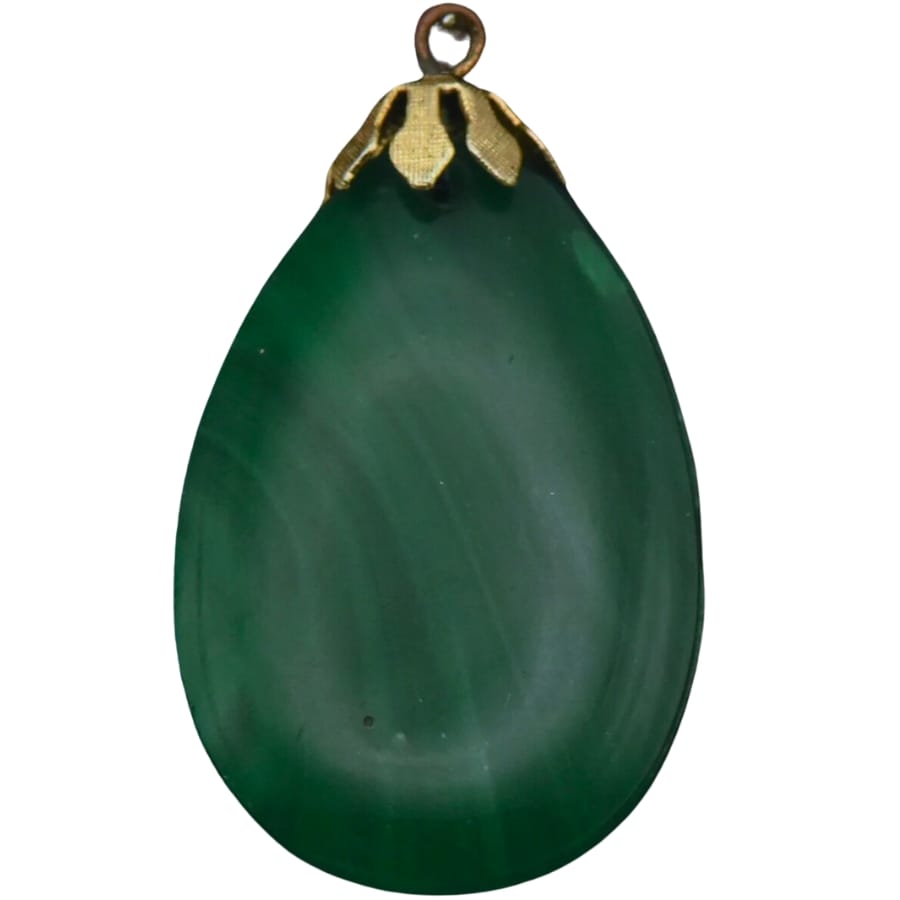
Glass is a common material used to make fake agate. It’s basically made by melting sand until it turns into a liquid. Once it cools down, it becomes solid glass. This process lets people shape and mold the glass into whatever form they want.
To make glass look like agate, manufacturers add different colors to the melted glass. They do this by mixing in various chemicals or minerals. They might pour the colored glass into molds that have the shape of agate stones.
After the glass cools and hardens, they can even polish it to make it look even more like real agate.
The final touch is sometimes adding artificial banding. These are lines or stripes painted or etched onto the glass to mimic the bands of a real agate.
How you can identify glass being sold as real agate
Look for bubbles
One big giveaway is bubbles. Real agate doesn’t have bubbles inside it, but glass often does. If you look closely and see tiny bubbles in the stone, it’s probably glass, not agate.
Check the edges
Glass tends to have sharper, more defined edges than agate. Agate’s edges are usually smoother and more rounded because of how it’s naturally formed.
Do a scratch test
Agate is pretty hard and tough, so it’s hard to scratch. Glass, however, is easier to scratch. If you can scratch the stone with something like a coin, it’s likely glass, not real agate. Remember to be gentle when doing this test to avoid damage.
Plastic
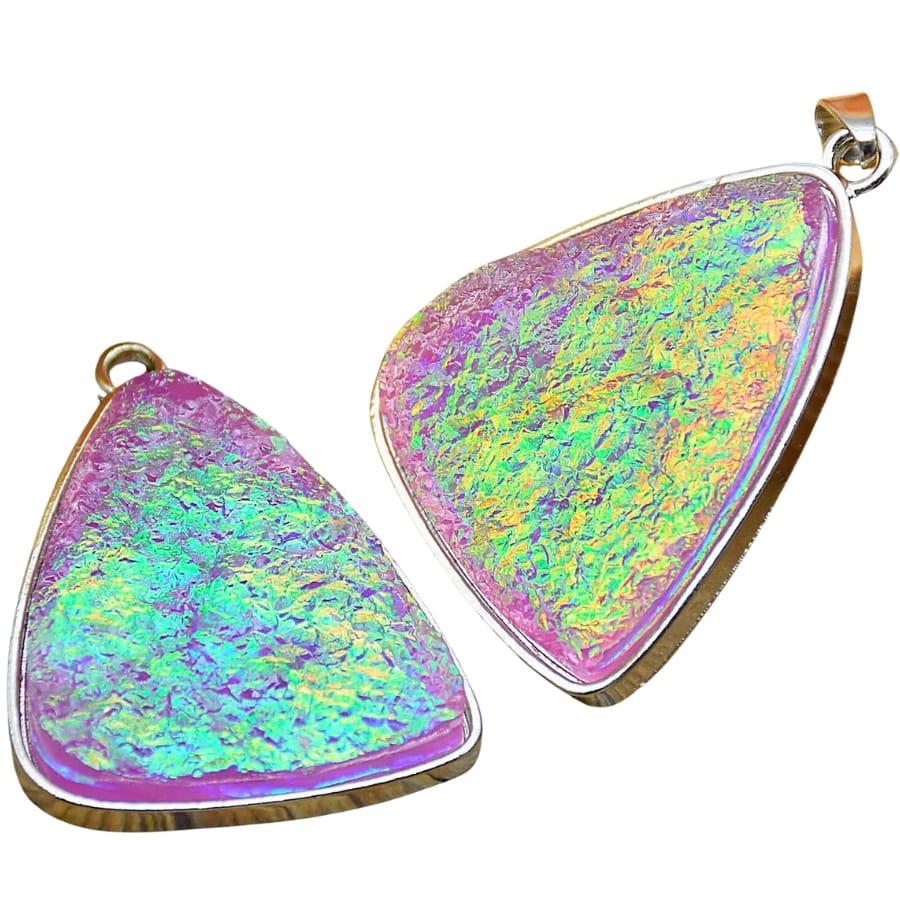
Plastic is another material that’s often used to make fake agate. It starts as a chemical mixture that’s mostly made from stuff found in oil. When these chemicals are heated and mixed together in different ways, they turn into plastic.
To make this material look like agate, manufacturers add colors to it with the use of all sorts of dyes. Sometimes they even add little pieces of shiny material to make it sparkle. The plastic is then poured into molds that are shaped like agate stones.
Once the plastic cools down and hardens in these molds, it takes on the shape and look of agate.
How you can identify plastic being sold as real agate
Feel the weight
Plastic is much lighter than real agate. If the stone feels really light for its size, it could be a sign that it’s made of plastic, not natural agate.
Check the temperature
Real agate stays cool to the touch, even in warm conditions. Plastic tends to warm up faster. If the stone feels warm quickly when you hold it, it might be plastic.
Examine the colors and patterns
Plastic can have colors and patterns, but they often look fake. They might be too bright or just not look natural. Real agate has more subtle and varied patterns.
Howlite
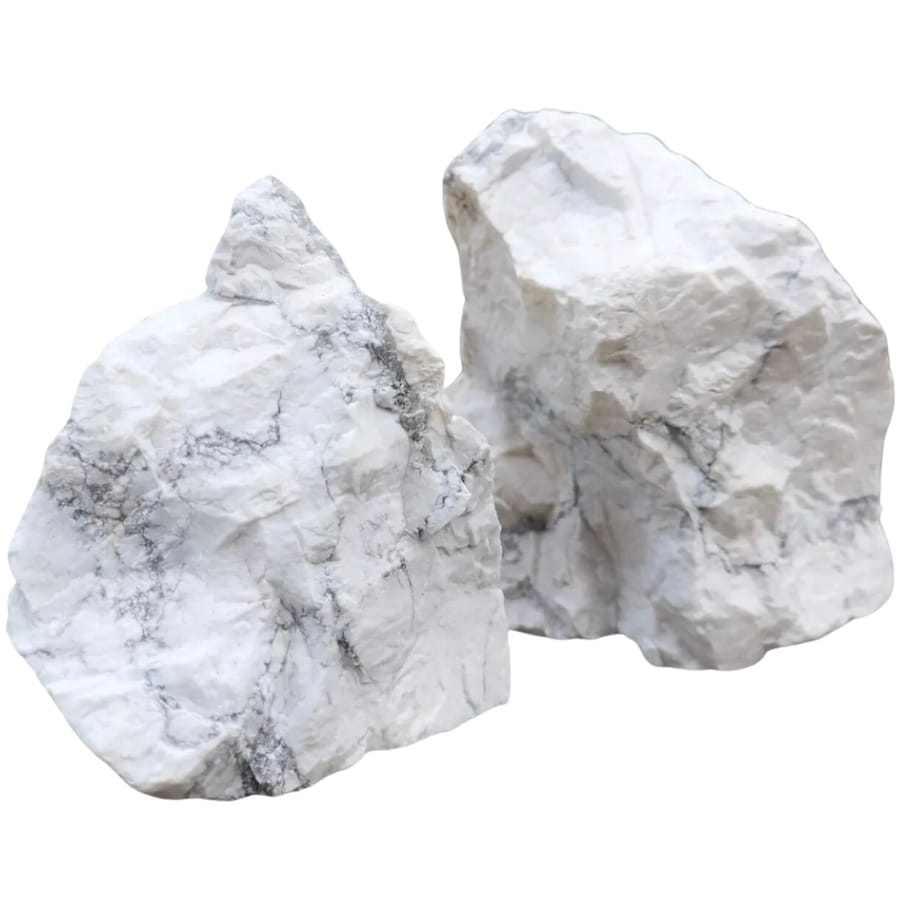
Howlite is naturally white or light gray and has cool web-like patterns of dark veins running through it. It forms mostly in places where there’s a lot of gypsum, another type of mineral. It’s usually found in big, rocky areas called sedimentary basins.
What’s neat about howlite is that it’s kind of like a blank canvas. It’s naturally light-colored, so it’s easy to dye it into different colors. This is why some people use it to make fake agate.
They take the howlite and add different colored dyes to it. The howlite soaks up these colors and can end up looking a lot like agate, especially to someone who might not know a lot about gemstones.
To make it look even more convincing, they sometimes polish it until it shines. This makes it look like a precious stone.
How you can identify howlite being sold as real agate
Look at the surface
Howlite has a porous surface, which means it has tiny holes. If you look closely and see these small pits or holes, it’s a sign that the stone might be howlite, not real agate.
Closely check the pattern and colors
Howlite is often dyed to look like agate, but its patterns are different. Real agate has natural, uneven banding, while dyed howlite has a web-like or marble-like pattern that doesn’t match agate’s bands.
Feel the weight and hardness
Howlite is lighter and not as hard as agate. If the stone feels lighter than you expect and can be scratched more easily (like with a steel nail), it’s likely howlite, not agate.
Jasper
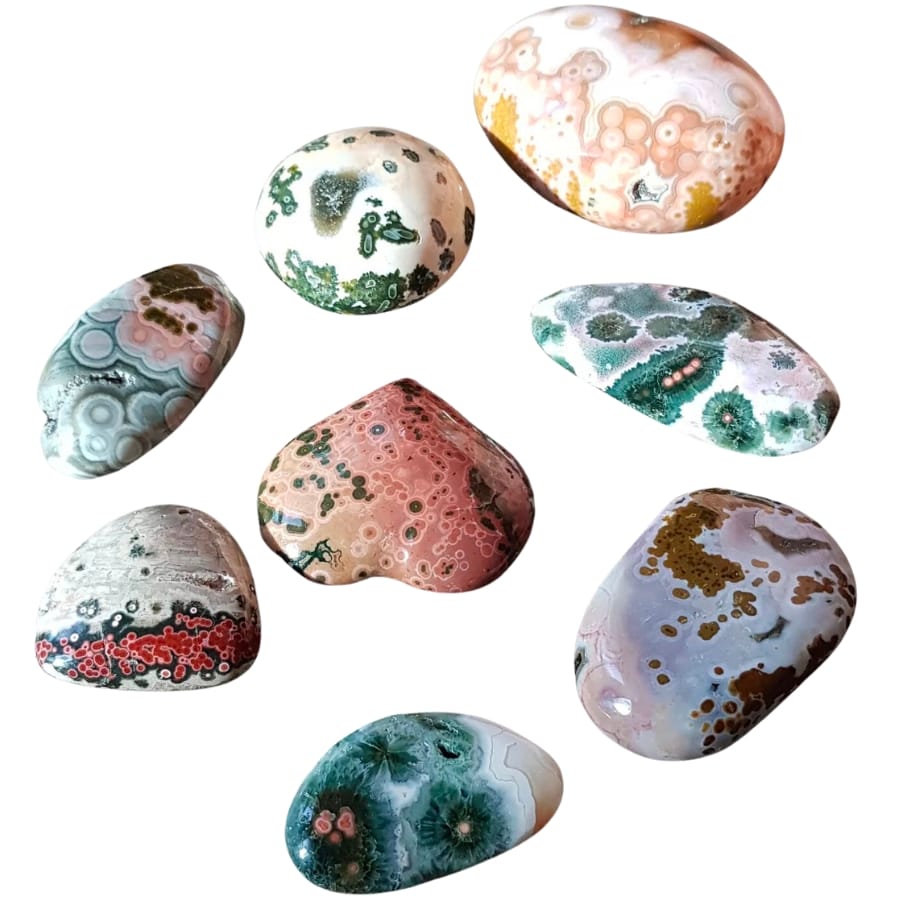
Jasper is a kind of quartz, which is one of the most common minerals on Earth. It forms when tiny particles of quartz get mixed with other minerals and materials.
This mix happens usually in places where there’s a lot of water movement, like rivers or beaches. Over time, all these particles get squished together really hard, turning into jasper.
It can be found in a lot of different colors that come from the different minerals that get mixed in with the quartz. But if you compare jasper vs agate, you’ll see that it doesn’t naturally have the banding or layered look of agate.
So to make jasper look like it, people sometimes dye it with colors that will make it look more like the banded patterns of real agate. They might also polish it to give it a nice shine.
How you can identify jasper being sold as real agate
Look at the transparency
Real agate is somewhat see-through or translucent, but jasper is not. If you can’t see any light passing through the stone, even a little bit, it might be jasper, not agate.
Feel the texture
Jasper can sometimes feel a bit grainier than agate. Agate is usually very smooth. If the stone feels a bit rough or less polished, it could be jasper.
Observe the colors
Jasper’s colors are often more uniform and less varied than agate’s. If the stone has very even, solid colors without the mix of shades you usually see in agate, it’s probably jasper.
Chalcedony
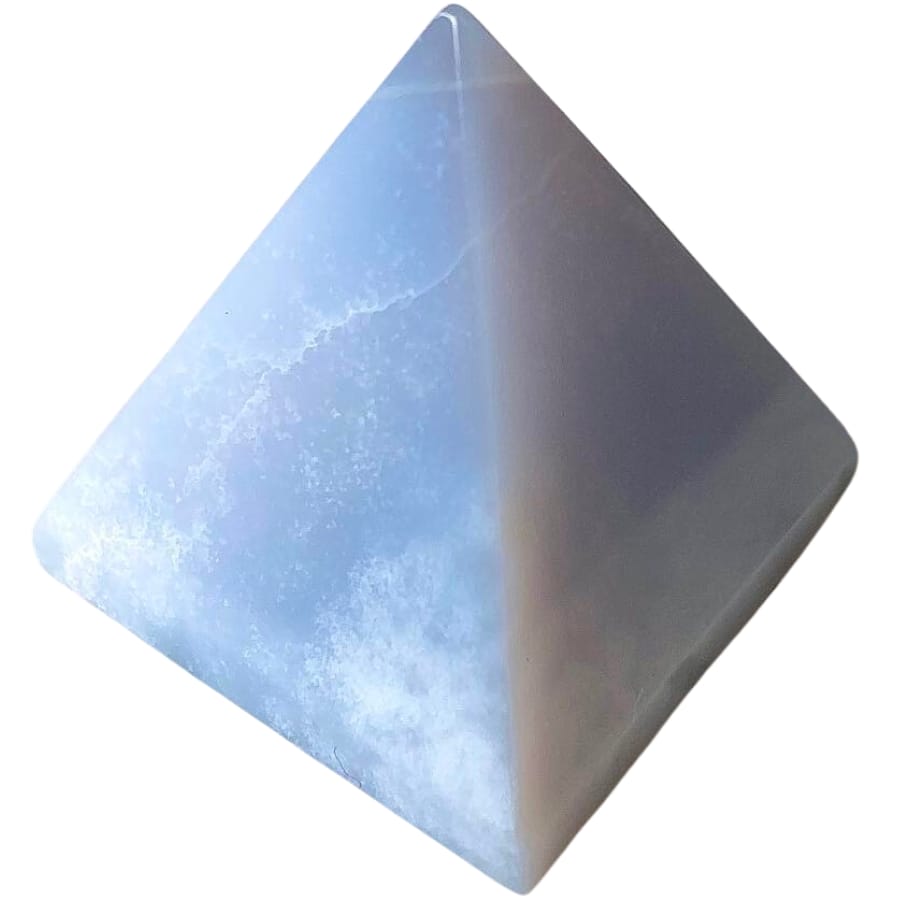
Chalcedony is actually related to agate, as they’re both made from quartz. It forms when tiny crystals of quartz come together in a special way. This usually happens in areas with lots of volcanic activity or hot springs.
What’s interesting about chalcedony is that it’s usually not very colorful on its own. It’s often kind of cloudy or a bit see-through and doesn’t have the bright colors or banding that agate has.
But, because it’s like a cousin to agate, it can be made to look similar with some tricks. For one, people often dye it to have those bright and varied patterns. They can also cut and polish it to make it look closer to the real deal.
How you can identify chalcedony being sold as real agate
Look at the transparency
Chalcedony is more cloudy or opaque, unlike agate, which is usually translucent. If you can’t see through the stone at all, it’s more likely to be chalcedony.
Notice the colors
Chalcedony usually has less vibrant colors compared to agate. If the stone’s colors seem muted or not very bright, it could be a sign that it’s chalcedony.
Feel the surface
Chalcedony can have a waxy or smooth surface, but it doesn’t feel as glassy as agate. If the stone feels different from the glass-like smoothness of agate, it’s likely chalcedony.
How To Tell If Agate Is Real Vs Fake
In this day and age, dishonest sellers are well capable of creating more fake agates from different materials aside from the ones we’ve already shared above. In this section, we’ll teach you how to sniff out a fake agate, be it cut, polished, or raw.
How to identify fake agate when it’s cut or polished
You should be wary of the following traits of fake agates when they are cut or polished:
Perfect or repetitive patterns
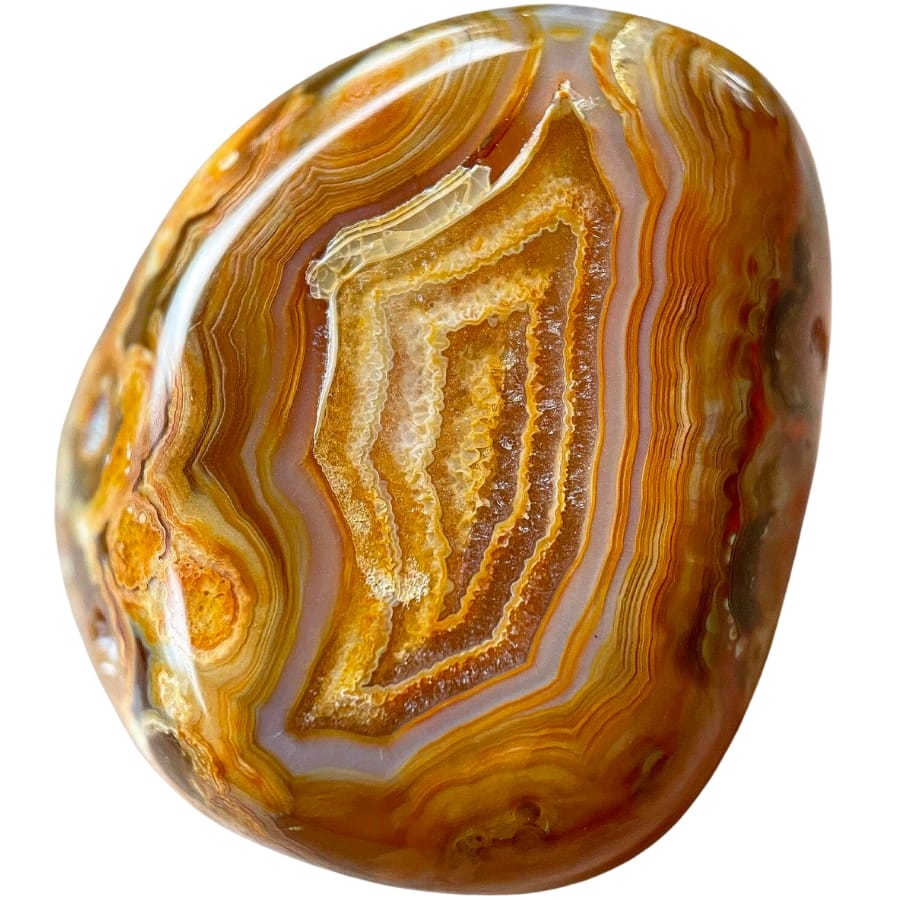
Real agate is known for having patterns or banding that are usually wavy, uneven, and really varied. But when people make fake agate, they often can’t perfectly copy these natural, random patterns.
Instead, its patterns tend to look too perfect or too repetitive. If you see a stone with banding that looks just too neat and orderly, or if every band is the same thickness and color, that’s a big clue it might not be real agate.
This happens because making fake agate involves machines and human-made processes. These methods are good at making things look the same, but they can’t easily replicate the random beauty of nature.
Opaque or completely clear
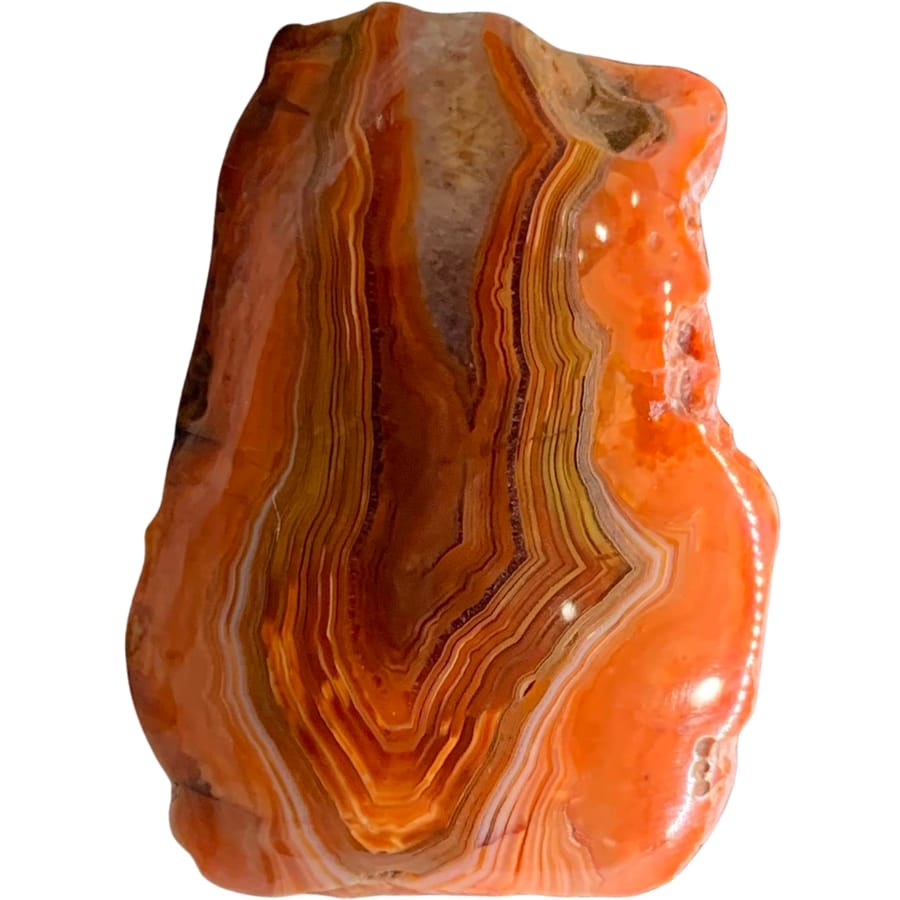
Real agate is kind of in the middle when it comes to transparency– not totally clear, but not completely solid in color either. We call this translucent, which means some light can pass through it, but not as much as through glass.
If you find a stone that’s either totally clear like glass or completely solid in color (opaque), it might not be real agate. Fake agates made from materials like glass, plastic, or other rocks can often be at these extremes.
Glass can be super clear, letting lots of light through. On the other hand, plastic or other rocks used to imitate agate might not let any light pass through, making them totally opaque.
Presence of bubbles

Bubbles are a big clue that the stone might be fake. Real agate, which is a natural stone, doesn’t have bubbles in it. But when it is faked using materials like glass or plastic, bubbles can often get trapped inside.
Let’s talk about glass first. When it’s made, it’s melted and then cooled down to form a solid. During this process, tiny air bubbles can get stuck inside. If you find them, it’s a good sign that the stone is not real agate, but actually glass.
Plastic can also have bubbles. Sometimes, air gets trapped inside the plastic as it’s being made. These bubbles can be a bit bigger and easier to spot than in glass.
In real agate, you won’t find these bubbles because it forms naturally over a long time, and this process doesn’t trap air like making glass or plastic does.
How to identify fake agate when it’s raw
As for fake agates that are in their raw form, try to watch out for these characteristics:
Smooth and shiny surface texture
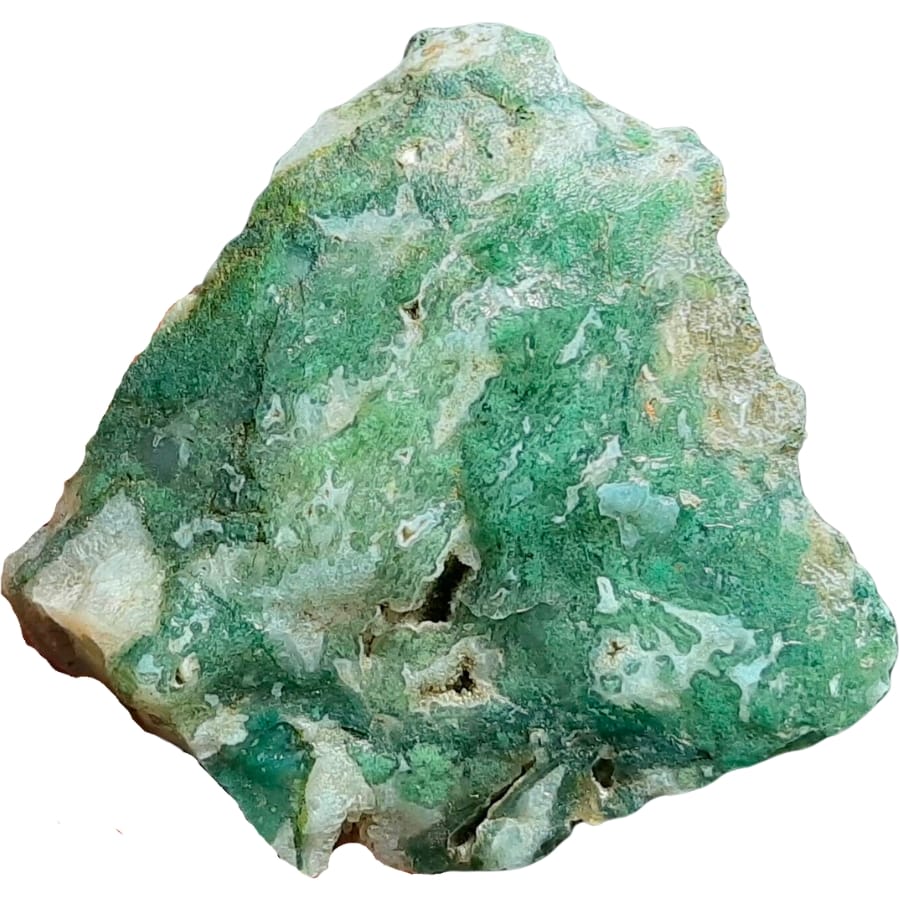
A raw real agate doesn’t usually look smooth and shiny. Instead, it has a rougher, more waxy kind of texture.
But sometimes, fake agate might have a smooth and shiny surface even when it’s supposed to be raw. This can happen when people use glass or plastic to make it.
These materials can be easily made to look smooth and shiny, but that’s not how real agate looks when it’s just been found, before any cutting or polishing.
Real raw agate should feel more natural and less like it’s been made smooth by people. It’s this natural, waxy feel that helps tell it apart from fakes.
Bright, uniform colors
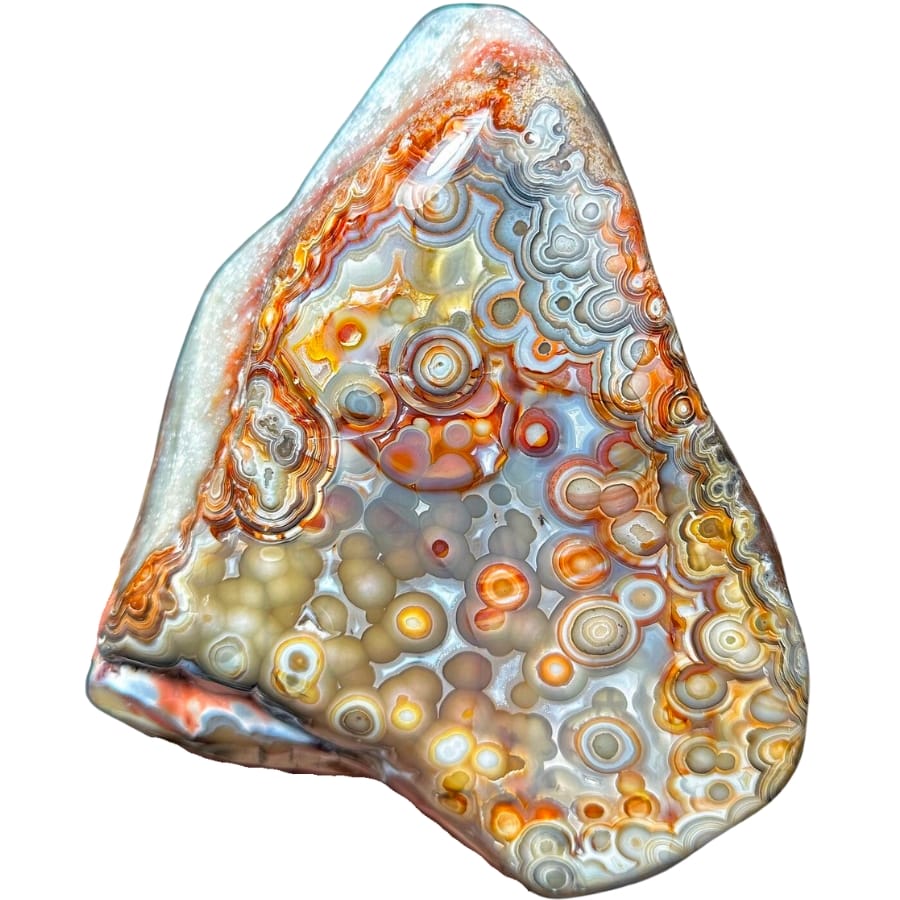
The colors of your stone can also tell you a lot about whether it’s real or fake. Real agate’s colors are more natural and varied. The colors blend into each other and there are different shades of it within a stone.
But with fake agate, the colors often look too bright or too perfect. They might be just one solid, bright color, or the colors don’t blend together like they do in nature.
This happens because fake agates are often dyed or painted to look pretty. People can make them any color they want, but they usually can’t get that natural, gentle blending of colors that real agate has.
Easily scratched
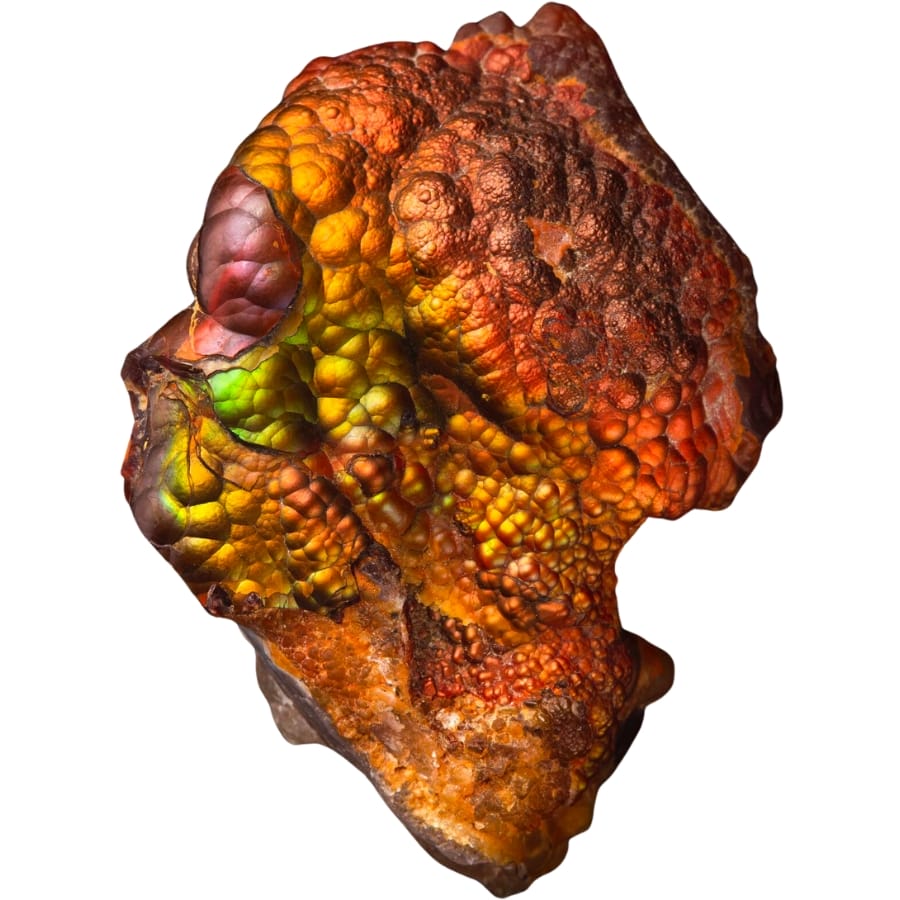
Real agate is pretty tough stuff so it doesn’t scratch easily. You could try gently running something like a steel nail over it. If it’s real, the nail shouldn’t leave a mark.
But, if the agate is fake, it might be made of softer materials like glass or plastic. These materials can be made to look like agate, but they’re not as hard. They can get scratched pretty easily.
So, if you gently scratch the stone and it leaves a mark, or if the scratch is very noticeable, there’s a good chance it’s a fake agate.
Remember to be gentle when doing this test. You don’t want to damage the stone or hurt yourself.

